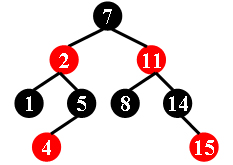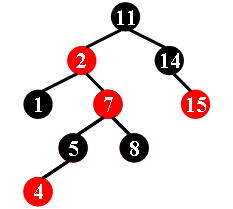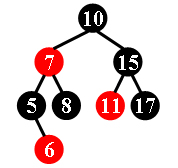There is a kind of balanced binary search tree named red-black tree in the data structure. It has the following 5 properties:
- (1) Every node is either red or black.
- (2) The root is black.
- (3) Every leaf (NULL) is black.
- (4) If a node is red, then both its children are black.
- (5) For each node, all simple paths from the node to descendant leaves contain the same number of black nodes.
For example, the tree in Figure 1 is a red-black tree, while the ones in Figure 2 and 3 are not.
 |
 |
 |
|---|---|---|
| Figure 1 | Figure 2 | Figure 3 |
For each given binary search tree, you are supposed to tell if it is a legal red-black tree.
Input Specification:
Each input file contains several test cases. The first line gives a positive integer K (≤30) which is the total number of cases. For each case, the first line gives a positive integer N (≤30), the total number of nodes in the binary tree. The second line gives the preorder traversal sequence of the tree. While all the keys in a tree are positive integers, we use negative signs to represent red nodes. All the numbers in a line are separated by a space. The sample input cases correspond to the trees shown in Figure 1, 2 and 3.
Output Specification:
For each test case, print in a line "Yes" if the given tree is a red-black tree, or "No" if not.
Sample Input:
3
9
7 -2 1 5 -4 -11 8 14 -15
9
11 -2 1 -7 5 -4 8 14 -15
8
10 -7 5 -6 8 15 -11 17
Sample Output:
Yes
No
No
看到 只给了我们先序序列直接蒙了,其实![]() 树还有一个性质,就是左小右大。
树还有一个性质,就是左小右大。
这样我们就可以区分出来左右子树了。
#include<bits/stdc++.h>
using namespace std;
typedef long long LL;
#define rep(i,a,b) for(int i=a;i<b;++i)
#define bug(x) printf("**x:%d\n",x)
const int N=310;
int arr[N];
map<int,int> col,ID;
vector<int> vec[N];
void get_tr(int* arr,int len)
{
if(len<=1)return;
int i=0;
for(; i<len; i++) {
if(arr[i]>arr[0])break;
}
int f=arr[0],u=arr[1],v=arr[i];
if(arr[1]<arr[0]) {
vec[ID[f]].push_back(u);
get_tr(arr+1,i-1);
}
if(i<len) {
vec[ID[f]].push_back(v);
get_tr(arr+i,len-i);
}
}
int dfs(int u,int f)
{
//printf("u:%d f:%d %d\n",u,f,ID[u]);
int t=ID[u];
int sz=vec[t].size();
if(sz==0) {
return col[u]==1?2:1;
}
int num=-1;
for(int i=0; i<sz; i++) {
int v=vec[t][i];
if(col[u]==-1&&col[v]==-1)return -1;
//printf(" v:%d\n",v);
int tmp=dfs(v,u);
//printf(" tmp:%d\n",tmp);
if(tmp==-1)return -1;
if(num==-1)num=tmp;
if(num!=tmp)return -1;
}
if(sz==1&&num!=1)return -1;
return num+max(col[u],0);
}
int tt[N];
void init()
{
ID.clear();
col.clear();
rep(i,0,N)vec[i].clear();
}
int main()
{
int T;
while(scanf("%d",&T)==1) {
rep(kase,0,T) {
init();
int n;
scanf("%d",&n);
rep(i,1,n+1) {
scanf("%d",&arr[i]);
col[abs(arr[i])]=(arr[i]>0?1:-1);
arr[i]=tt[i]=abs(arr[i]);
}
sort(tt+1,tt+n+1);
rep(i,1,n+1) {
ID[tt[i]]=i;
}
get_tr(arr+1,n);
int f=dfs(arr[1],-1);
if(col[arr[1]]<0)f=-1;
if(f!=-1)printf("Yes\n");
else printf("No\n");
}
}
return 0;
}